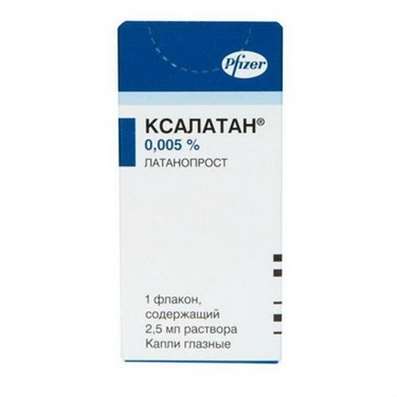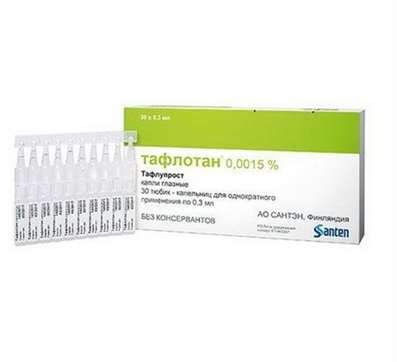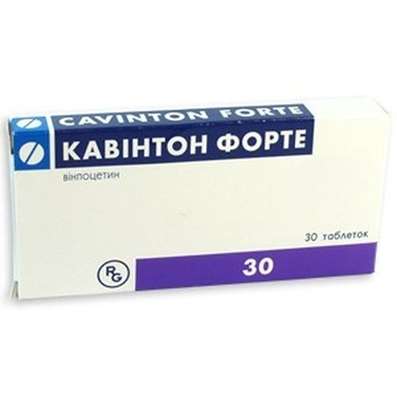Travatan eye drops - is an antiglaucoma preparation that is an aqueous solution of travoprost (a synthetic analogue of prostaglandin F2-alpha) for use in ophthalmic practice. It is prescribed to lower intraocular pressure in patients with glaucoma and to treat ophthalmic hypertension. The mechanism of action of the drug is due to the stimulation of the outflow of the intraocular fluid filling the space between the lens and the cornea, leading to a decrease in intraocular pressure. The drug prevents or slows the further progression of glaucoma and helps to avoid the occurrence of severe complications.
Travatan eye drops - antiglaucoma preparation. Synthetic analogue of prostaglandin F2α.
It is a highly selective agonist of prostaglandin FP receptors. Reduces intraocular pressure due to increased uveoscleral outflow of aqueous humor.
Intraocular pressure decreases approximately 2 hours after application of the drug, the maximum effect is achieved after 12 hours.
Pharmacokinetics
Absorption and Metabolism
Travoprost is absorbed through the cornea of the eye, where hydrolysis of travoprost occurs to a biologically active form - travoprost acid.
Cmax of travoprost in blood plasma is reached within 30 minutes after topical application and is 25 pg / ml or less.
Excretion
Travoprost is quickly removed from the plasma, within an hour the concentration drops below the detection threshold (<10 pg / ml).
Travoprost is excreted as inactive metabolites mainly with bile (61%), the rest is excreted by the kidneys.
Indications:
Decreased elevated intraocular pressure under the following conditions:
- open-angle glaucoma;
- increased ophthalmotonus.
Contraindications:
- children and adolescents under 18;
- hypersensitivity to the components of the drug.
Caution should be given to patients who have risk factors for developing macular edema (aphakia, pseudofakia, damage to the posterior capsule of the lens), with acute iritis, uveitis.
Special instructions:
The drug can cause a gradual change in eye color by increasing the amount of brown pigment in the iris. This effect is revealed mainly in patients with mixed iris color, for example, blue-brown, gray-brown, green-brown or yellow-brown, which is explained by the increase in melanin content in the stromal melanocytes of the iris. Typically, brown pigmentation spreads concentrically around the pupil to the periphery of the iris of the eyes, while the entire iris or parts of it can acquire a more intense brown color.
In patients with uniformly colored eyes of blue, gray, green or brown, eye color changes after two years of use of the drug were very rare. The color change is not accompanied by any clinical symptoms or pathological changes.
After the drug was discontinued, there was no further increase in the amount of brown pigment, but the already developed color change may be irreversible.
Before starting treatment, patients should be informed about the possibility of changing eye color.
Treatment of only one eye can lead to permanent heterochromia.
In the presence of nevi or lentigo on the iris, their changes were not observed under the influence of the drug.
The drug may cause darkening, thickening and lengthening of the eyelashes and / or an increase in their number; rarely - darkening of the skin of the eyelids.
Travatan can be used in combination with other antiglaucoma drugs for topical use. In this case, the interval between their use should be at least 5 minutes.
When wearing contact lenses before instillation of the drug, the lens should be removed and reassembled no earlier than 20 minutes after the procedure.
The bottle must be closed after each use.
Side effects:
From the side of the organ of vision: in 35% of cases - transient weakly expressed conjunctival hyperemia, passing alone; in 5-10% of cases - reduced visual acuity, a feeling of discomfort and foreign body, pain, itching, burning sensation in the eyes; in 1-4% of cases - visual disorders, blepharitis, fog before the eyes, cataracts, conjunctivitis, dry conjunctiva, changes in color of the iris, keratitis, crust formation on the edges of the eyelids, photophobia, subconjunctival hemorrhages and increased lacrimation.
From the cardiovascular system: in 1-5% of cases - an increase or decrease in blood pressure, bradycardia, angina pectoris, chest pain, hypercholesterolemia.
From the side of the central nervous system: in 1-5% of cases - general anxiety, headache, depression.
From the urinary system: in 1-5% of cases - urinary incontinence and urinary system infection.
From the musculoskeletal system: in 1-5% of cases - arthritis, back pain.
Other: in 1-5% of cases - flu-like syndrome, sinusitis, bronchitis, dyspepsia.
Suggested Use:
The drug is instilled in 1 drop in the conjunctival sac of the affected eye (eye) 1 time / day, preferably in the evening. More frequent use of the drug may lead to a decrease in its effectiveness.
Packaging:
- Comes in original packaging. Item is brand new and unopened.
Storage:
- Keep away from direct sunlight.
- Keep locked and away from children.
- Store in dry place at room temperature.
- Do not exceed storage temperature higher than 25 C
Important notice- the outer box design may vary before prior notice!

 Cart
Cart





